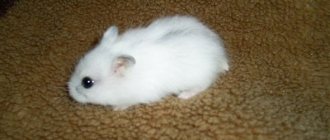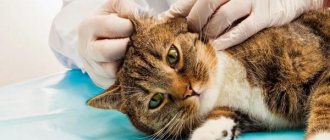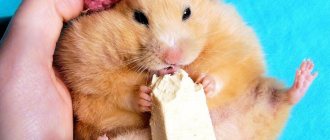- Products prohibited for consumption
The debate about what species the Angora hamster belongs to is not groundless. Many consider it a separate species in the hamster family, which is fundamentally wrong. In fact, this is a variety of Syrian individuals, differing in the quality of their coat. This is what they call Angora.
Individuals can be long-haired or short-haired. Their ubiquity is due to their great popularity among people. To have information about what an Angora hamster looks like, you can see the photo at the end of the article.
Characteristics of Angora hamsters
What do you need to know to buy a healthy hamster? | Signs of a healthy animal:
It is better to purchase a pet at the age of 1.5 - 2 months, then it is easy to train and accustom it to the tray. |
Is it possible to keep several individuals in one cage or aquarium? | This is strictly prohibited. Hamsters will fight and cause serious injury to each other. |
Do I need a rabies vaccine after a hamster bite? | Bites from a healthy rodent are not dangerous, but are quite painful and, due to the special structure of the rodent’s teeth, can cause quite heavy bleeding. The wound needs to be washed, treated with hydrogen peroxide, alcohol or brilliant green, and can be covered with a band-aid. |
What not to do to avoid pet bites? |
|
This subspecies is not much different from other hams. In everyday life he is quite unpretentious and clean. Angora hamsters live for about 2 - 3 years; if all necessary conditions are strictly observed, they can live up to a maximum of 4 years. Geographically, the variety is distributed in Central Asia, North and South America.
The cost of an Angora hamster in Russia averages 200 – 350 rubles, depending on the region and place of purchase (pet store, poultry market). Since hamsters reproduce easily and quickly, and the offspring need to be placed somewhere, it is quite possible to receive an animal as a gift or for a symbolic price from acquaintances and friends. But the expenses won’t end there, because the hamster will definitely need a cage, food and various accessories: exercise equipment, a drinking bowl and feeder, a bathtub.
Advantages of keeping a subspecies:
- It is almost silent and undemanding in terms of conditions - it requires a small area for keeping, little food, and can be trained to go to the toilet in a special tray.
- Gets along well with children and is calm about squeezing and excessive displays of affection.
- It quickly becomes tame and can be trained.
- Easily reproduces in captivity.
- Very clean and disease resistant.
- Affordable price.
- An excellent pet for a novice breeder or children over one year old.
Difficulties in content:
- He is prone to obesity, so he needs exercise equipment and a balanced diet.
- Requires the acquisition of certain maintenance attributes: chalk stone, drinking bowl, cage, bath, wheel.
- It is nocturnal and can hibernate.
- It chews wires, furniture, and shoes, so it requires being in a cage or aquarium.
- If not regularly cleaned, the cage becomes a source of unpleasant odor.
- Can't stand neighbors. If you plan to keep a second rodent, a second cage is necessary.
Typically, rodents hibernate when the temperature drops to 10 degrees. Such situations should be avoided. If the hamster does fall asleep, warm him up with the warmth of your own hands as soon as possible.
Character and training
Watching a pet is a pleasure, but playing with it and training it is a completely different feeling. This type of rodent is friendly to people and gets along well with children. Some livestock breeders claim that their pets respond to the voice of the owner pronouncing the name “fluffy”.
It is important to remember that only young individuals aged from one and a half to two months can be trained. Such “fluffies” can be trained to litter, beg and other tricks. In order for the “baby” to get used to the owner, you first need to talk to her a lot. When the pet is no longer afraid of humans, you can safely pick it up.
If a hamster is accustomed to human company from infancy, it will easily and naturally play with children and adults, allow itself to be squeezed and stroked.
Maintenance and care
Cage, feeder and other attributes
Your hamster will definitely need a cage with a closed top. Preferably made of metal, but not copper. The optimal area is 30x40 cm, height is about 30 cm. It is better to purchase a cage with small horizontal bars so that the pet cannot squeeze through them, chew through them, but at the same time there is an opportunity to climb on them. The living space is filled with pieces of wood and twigs, which can be used to grind down constantly growing teeth. The floor is covered with a special filler, wood pellets, sawdust or coarse sand. In addition to the cage, the hamster can be kept in an aquarium or terrarium with a closed mesh top.
The cage must be installed on a hill away from heating devices and direct sunlight. Eliminate drafts, but provide a constant flow of fresh air. Make sure your pet is not afraid of pets such as dogs or cats. The walls of the cage should not come into contact with curtains or other fabrics or wallpaper, anything that the hamster can reach and chew. In addition, the hamster will need a litter box - a special litter sold in pet stores that is poured into the corner of the cage. You can pour it not directly into the corner, but onto a flat, easy-to-clean tray.
A plywood or plastic house is usually used as a nest, the bottom of which is covered with soft material: hay, fluff, pieces of fur, paper or fabric. It is better not to use cotton wool, especially if you are planning offspring: the hamster's legs or cubs may get tangled. Newspapers are also not suitable: printing ink is quite harmful to rodents.
Hamsters are constantly on the move in nature, so they are always in great shape. Caring for and keeping an Angora hamster at home almost eliminates any activity: there is no need to obtain food, movements are limited to the territory of the cage, and there is no need to escape from enemies. Therefore, the pet needs exercise equipment to implement increased activity. The best option is a running wheel. You can purchase additional ladders, tunnels, hammocks, and shelf-floors.
The wheel for an Angora must be larger than for other species: at least 20 centimeters, otherwise the rodent will get tangled in its own fur while running. Choose a wheel with a solid surface to avoid injury to the paws. Additionally, you can purchase a walking ball, which is convenient for letting your pet out for a walk around the apartment.
The more simulators there are in the habitat and the more often the situation changes there, the more active, and therefore healthier, your pet will be and, accordingly, will live longer.
It is better to buy a small drinking bowl - the hamster drinks little, especially if there is a sufficient amount of juicy food. But the water needs to be changed regularly. Any easy-to-clean small container will be suitable as a feeder. There should be two feeders - for dry and wet food.
The last, but very important accessory for the cage is a mineral (chalk) stone. It is designed for grinding teeth. Without this, your pet's teeth may grow so long that they interfere with his life.
Cleaning the cage
Hamsters are very clean creatures, so cleaning must be done regularly. If your pet relieves itself in a tray, then cleaning will be needed about twice a week and will only take about 10 minutes. First, remove the rodent from the cage - put it in a carrier, in the children's hands, in a walking ball, or, in extreme cases, in a jar with a small amount of food at the bottom.
Then the hamster's housing must be freed of all accessories, washed with warm water and dried. Do not use chemical detergents. If the cage is very dirty, purchase a special cleaning product. Be sure to wash the feeders, drinker, tray, wheel and everything else. Sift the granules or other filler from the cage tray, discard the debris, rinse and dry.
To prevent your pet from experiencing stress when returning to a home where there is no “native smell” left, leave a little of the litter from the dirty cage unwashed and sprinkle it on the floor after cleaning.
Grooming
Keeping Angora hamsters can be a bit of a hassle when it comes to grooming. It is quite long and furry, so it needs to be combed regularly to remove entangled food particles and debris.
A regular toothbrush is suitable for the procedure. If desired, you can purchase a special cleaning powder. To make the wool less dirty, it is better to use wood pellets instead of sawdust, which usually lines the floor of the cage.
Bathing
The hamster will not need bathing in the generally accepted sense of the word. Moreover, water procedures are contraindicated for your pet. He could easily catch a cold and die from it. The rodent washes itself almost like a cat - with its tongue and paws. He also cleans his fur in a container with sand. You can purchase a special filler, for example, for chinchillas or other rodents, or use regular river sand.
Factors influencing life expectancy
The lifespan of Angoras is directly affected by their care. The Angora hamster, the photo of which is posted below, usually looks like a happy, carefree pet. With proper organization of living space and lifestyle, there will be no disputes about how long Angora hamsters live.
In favorable conditions, with the organization of the correct diet, constant vaccination and examinations by a veterinarian, an individual can live up to four years. By the way, in the wild, such animals live no more than two to three years, and careless individuals live for less than a year. Factors influencing the life expectancy of pets are:
- conditions for organizing living space before acquisition by a new owner;
- creation of favorable conditions during transportation;
- monitoring the maintenance of order in the baby’s home;
- organizing a proper diet;
- absence of injuries and illnesses.
Feeding an Angora hamster
What to feed an Angora hamster is one of the main and most important issues of keeping. Since the subspecies was bred in captivity, a balanced diet with sufficient vitamin content is extremely important for it. The basis of the diet is:
- Fiber (cereals: plain, oats, flax) - daily.
- Plant protein (nuts, berries, fruits, dried fruits and vegetables) – daily.
- Protein foods of animal origin (cottage cheese, kefir, chicken meat without salt and seasonings) - a couple of times a week.
You can give your hamster:
- Cereal and dry fruit mixtures from pet stores specifically for rodents.
- Hamster treats from the same store - grain and grass sticks, granules, biscuits and cookies, rings and crackers.
- Small quantities of seeds (pumpkin, melon, sunflower).
- Egg white (once a week).
- Apples, pears, grapes, bananas, apricots are the most loved by rodents, but you can also give other non-prohibited fruits.
- Tomatoes, pumpkin, carrots and other vegetables that are not on the list of prohibited foods.
- Berries – raspberries and strawberries (in small quantities).
- Porridge without sugar (for example, for children).
- Low-fat yoghurts without additives or preservatives.
- Greens - dandelion leaves, plantain, clover, dill, parsley, lettuce, celery).
- Mealworms (once every 10 days).
Fruits should be thoroughly pitted. Fruit acid, which is found in fruit seeds, is deadly to rodents.
Prohibited products:
- Citrus.
- Onion and garlic.
- Cabbage.
- Potato.
- Exotic fruits.
- Watermelon.
- Honey.
- Pasta.
- Mushrooms.
- Sorrel.
- Persimmon.
- Almond.
- Sweet.
- Salty.
- Smoked.
- Pickled.
- Canned food.
- Food from the human table.
Daily diet for a furry pet
Angoras are more picky about the quality of food than dwarfs or other dwarf rodents. Their daily diet should include not only cereal grains (oats, corn, millet) but also vitamins. Pet stores sell special food for pets, which contains a complex of useful substances. However, your pet can also get vitamins from fruits and vegetables, which it is advisable to include in his daily food.
Angora hamsters readily eat carrots, pumpkin, apples, lettuce and dandelion leaves, dill, and parsley. Rodents will also get the necessary substances from sunflower seeds and nuts. To replenish protein reserves, your pet can be fed with boiled liver and boiled chicken meat. The main thing is that all the food in the hamster's feeder is fresh.
You should feed your pet no more than twice a day. It is advisable to replenish the supply of drinking water in his home approximately once every two days.
From time to time it is necessary to conduct an audit of the fluffy's house and check what he has brought into his pantry. There should not be too much perishable food in a hamster’s diet, otherwise the consequences may be disappointing. A long-haired rodent can not only stain its coat with vegetables or fruits that have begun to rot, but also become seriously ill.
To avoid unpleasant consequences, it is necessary to exclude potatoes, cabbage leaves, garlic, onions, and citrus fruits from the Angora hamster’s diet. It is advisable to avoid various exotic fruits and fruits with seeds.
Since Angora hamsters are prone to obesity, their feeding should be done under the supervision of the owner. In the house the animal should have many accessories for active body movements.
Reproduction and care of offspring
The hamster will not tolerate being around other rodents of the same sex, so a second pet needs a different cage. It is also not recommended to house a male with a female. You will not have time to distribute numerous offspring. Hamsters, including Angoras, have the shortest period of gestation among all mammals - only 14 to 20 days. Females give birth to from 4 to 18(!) hamsters at a time. At the age of 1.5 months, individuals are already ready to reproduce. In this case, the female can bring several litters per year.
You can mate hamsters of different breeds, but it is better to choose a pair with approximately the same size. This is due to the fact that a pregnant female becomes very warlike and can easily injure, and in the case of its small size, even kill, the father of her own children. Therefore, the male, having done his job, is immediately placed in another cage. If he is outwardly friendly, still do not leave him with the female. Often the male destroys the nest with the babies and may bite or eat them.
Some breeding features:
- It is easier to get offspring from young hamsters than from older ones.
- Angoras can give birth to both long-haired and short-haired hamsters.
- It is impossible to predict the color of future children.
- Females often eat part or all of the offspring. Experts attribute this to a lack of protein food in the mother’s body. Therefore, a few days before giving birth, feed your hamster intensively with chicken and egg whites. You can give milk.
In the first week after birth, it is strictly forbidden to handle baby hamsters. The female can eat the cubs, on the skin of which the smell of human hands is preserved.
Is the white hamster a separate breed?
Many people think that all white hamsters belong to the same breed. But is this really so? In general, this is a very big misconception. Breeders have spent decades trying to develop animals with different colors within each rodent breed. Of course, in nature, a white hamster is extremely rare, because such a color is inappropriate for the survival of a defenseless animal. Therefore, the evolution of hamsters was aimed at acquiring a protective color - gray or brown.
But animals that are kept not in the natural environment, but under human care, can be of different colors, because they are not exterminated by predators as the most noticeable individuals. Moreover, people purposefully kept light-colored hamsters for their breed because of their extraordinary beauty! Repeated crossings led to the creation of animals with snow-white fur within the breed.
But the color of pets does not always depend on the success of breeders. If we summarize the reasons for the snow-white color of an animal’s fur, we get the following list:
- Selection. Light color is found in Djungarian and Chinese hamsters, Syrian, and Campbell's hamsters.
- Seasonal coloring. Representatives of some breeds shed in the fall and develop light-colored fur. This seasonal color is typical for dzhungariks.
- Albinism. A genetic disorder in which there is a lack of pigmentation in the skin, fur and eyes. The phenomenon is rare, but absolutely independent of the breed of the animal.
Thus, white hamsters are by no means a separate breed.
Diseases
Most often, the health of Angora and other hamsters suffers from the following diseases:
- Diarrhea (diarrhea) - usually caused by eating too much raw vegetables.
- Constipation is associated with a lack of water and abuse of dry food.
- Colds and flu.
- Infectious diseases of the kidneys and bladder.
- Wet Tail is a contagious and very dangerous disease characterized by diarrhea, rectal bleeding, and ruffled and wet fur in the belly and tail area.
- Fractures and bites from other hamsters.
- Demodectic mange (mites).
- Rectal prolapse (resulting from diarrhea or constipation).
- Interites.
- Cystitis.
- Inflammation of the cheek pouches - usually as a result of damage to the epithelium by sharp objects.
- Lymphocytic choriomeningitis - affects hamsters up to 3 months.
- Baldness and lichen.











